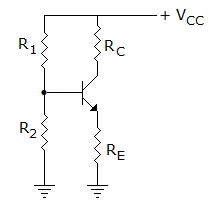Discussion
Home ‣ Electronics and Communication Engineering ‣ Radio Receivers See What Others Are Saying!
- Question
Which of the following noise does not occur in transistors?
Options- A. Partition noise
- B. Shot noise
- C. Flicker noise
- D. Resistance noise
- Correct Answer
- Partition noise
- 1. Consider the following statements about instrument landing system of aircraft
- It ensures correct landing under conditions of low visibility.
- It consists of runaway localizer, glide path equipment and marker beacons.
- It is basically a blind landing system.
Options- A. All
- B. 1 and 2 only
- C. 1 and 3 only
- D. 2 only Discuss
- 2. The specified maximum junction temperature of thyristors is about
Options- A. 50°C
- B. 80°C
- C. 120°C
- D. 200°C Discuss
- 3. In figure the saturation collector current is

Options- A.

- B.

- C.

- D. none of the above Discuss
- 4. The source of which of the following noise is different from that of the remaining?
Options- A. Solar noise
- B. Cosmic noise
- C. Galactic noise
- D. Atmospheric noise Discuss
- 5. If peak value of input voltage is Vm and firing angle is a, the average output voltage for single phase half wave and single phase full wave regulators are
Options- A.

- B.

- C.

- D.
 Discuss
Discuss
- 6. Radio broadcasting is a familiar example of
Options- A. space multiplexing
- B. time multiplexing
- C. frequency multiplexing
- D. none of the above Discuss
- 7. A line has a phase constant of 29.8 rad/m. At 1000 MHz the wavelength is
Options- A. 29.8 m
- B. 2.98 m
- C. 2.1 m
- D. 0.21 m Discuss
- 8. The class of insulation of impregnated paper is
Options- A. A
- B. B
- C. C
- D. F Discuss
- 9. The quality of a space-link is measured in terms of the __________ ratio.
Options- A. C/N
- B. S/N
- C. G/T
- D. EIRP Discuss
- 10. For a 50 ? resistor for 3 GHz application, the stray capacitance should be less than
Options- A. 1 ?F
- B. 1 nF
- C. 1 pF
- D. 0.1 pF Discuss
More questions
Correct Answer: All
Correct Answer: 120°C
Correct Answer:

Explanation:
Since IE ≂ IC,  .
.
 .
.
Correct Answer: Atmospheric noise
Correct Answer:

Correct Answer: frequency multiplexing
Correct Answer: 0.21 m
Explanation:
 .
.
Correct Answer: A
Correct Answer: C/N
Correct Answer: 0.1 pF
Explanation:
XC should be at least ten times greater than R. Therefore for 50 ? resistor at 3 GHz, C should be less than 0.1 pF.
Comments
There are no comments.More in Electronics and Communication Engineering:
Programming
Copyright ©CuriousTab. All rights reserved.
